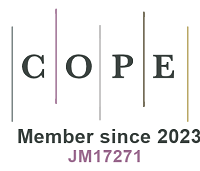REFERENCES
1. WHO. Domestic water quantity, service level and health. Available from: https://www.who.int/publications/i/item/9789240015241 [Last accessed on 14 Sep 2022].
2. OECD. Water and agriculture. Available from: https://www.oecd.org/agriculture/topics/water-and-agriculture/ [Last accessed on 14 Sep 2022].
4. EEA. EEA Report No 9/2021: drivers of and pressures arising from selected key water management challenges. A European overview. Available from: https://www.eea.europa.eu/publications/drivers-of-and-pressures-arising [Last accessed on 14 Sep 2022].
5. Griffiths JK. Waterborne diseases. In: International Encyclopedia of Public Health (Second Edition). Elsevier 2017; doi: 10.1016/B978-0-12-803678-5.00490-2. p. 388-401
6. Cristian PG, Raluca IA. On the economics of climate change and health: an overview. In: The impact of climate change on our life. Singapore: Springer; 2018. p. 79-96. Available from: http://link.springer.com/10.1007/978-981-10-7748-7_4 [Last accessed on 14 Sep 2022].
7. WHO. Diarrhoeal disease. Available from: https://www.who.int/en/news-room/fact-sheets/detail/diarrhoeal-disease [Last accessed on 14 Sep 2022].
8. UNICEF. Progress on household drinking water, sanitation and hygiene I 2000-2017. Available from: https://data.unicef.org/resources/progress-on-household-drinking-water-sanitation-and-hygiene-2000-2020/ [Last accessed on 14 Sep 2022].
9. Bartley PS, Domitrovic TN, Moretto VT, et al. Antibiotic resistance in enterobacteriaceae from surface waters in urban brazil highlights the risks of poor sanitation. Am J Trop Med Hyg 2019;100:1369-77.
10. O’Brien E, Xagoraraki I. A water-focused one-health approach for early detection and prevention of viral outbreaks. One Health 2019;7:100094.
11. Agegnehu F, Shimeka A, Berihun F, Tamir M. Determinants of malaria infection in Dembia district, Northwest Ethiopia: a case-control study. BMC Public Health 2018;18:480.
12. Cwiklinski K, O’Neill SM, Donnelly S, Dalton JP. A prospective view of animal and human Fasciolosis. Parasite Immunol 2016;38:558-68.
13. Tomasino MP, Semedo M, Vieira E Moreira P, et al. SARS-CoV-2 RNA detected in urban wastewater from Porto, Portugal: method optimization and continuous 25-week monitoring. Sci Total Environ 2021;792:148467.
14. Godini H, Hoseinzadeh E, Hossini H. Water and wastewater as potential sources of SARS-CoV-2 transmission: a systematic review. Rev Environ Health 2021;36:309-17.
15. Franklin AB, Bevins SN. Spillover of SARS-CoV-2 into novel wild hosts in North America: a conceptual model for perpetuation of the pathogen. Sci Total Environ 2020;733:139358.
16. De Paula VS, Diniz-Mendes L, Villar LM, et al. Hepatitis A virus in environmental water samples from the Amazon Basin. Water Res 2007;41:1169-76.
17. Amrose SE, Cherukumilli K, Wright NC. Chemical contamination of drinking water in resource-constrained settings: global prevalence and piloted mitigation strategies. Annu Rev Environ Resour 2020;45:195-226.
18. Zulkifli SN, Rahim HA, Lau WJ. Detection of contaminants in water supply: a review on state-of-the-art monitoring technologies and their applications. Sens Actuators B Chem 2018;255:2657-89.
19. FAO. More people, more food, worse water? Available from: http://www.fao.org/3/ca0146en/ca0146en.pdf [Last accessed on 14 Sep 2022].
20. Charuaud L, Jardé E, Jaffrézic A, et al. Veterinary pharmaceutical residues in water resources and tap water in an intensive husbandry area in France. Sci Total Environ 2019;664:605-15.
21. Karki NP, Colombo RE, Gaines KF, Maia A. Exposure to 17β estradiol causes erosion of sexual dimorphism in Bluegill (Lepomis macrochirus). Environ Sci Pollut Res 2021;28:6450-8.
22. Burkholder JM, Tomasko DA, Touchette BW. Seagrasses and eutrophication. J Exp Mar Biol Ecol 2007;350:46-72.
23. Knobeloch L, Salna B, Hogan A, Postle J, Anderson H. Blue babies and nitrate-contaminated well water. Environ Health Perspect 2000;108:675-8.
24. Yadav R, Yadav P, Singh G, Kumar S, Dutt R, Pandey A. Non infectious causes of abortion in livestock animals - a review. Int J Livest Res 2021;11:1-13. Available from: https://www.bibliomed.org/mnsfulltext/68/68-1602671806.pdf?1663555176 [Last accessed on 14 Sep 2022]
25. Cousins IT, Johansson JH, Salter ME, Sha B, Scheringer M. Outside the safe operating space of a new planetary boundary for per- and polyfluoroalkyl substances (PFAS). Environ Sci Technol 2022;56:11172-9.
26. De Silva AO, Armitage JM, Bruton TA, et al. PFAS exposure pathways for humans and wildlife: a synthesis of current knowledge and key gaps in understanding. Environ Toxicol Chem 2021;40:631-57.
28. EFSA. Food contact materials. Available from: https://www.efsa.europa.eu/en/topics/topic/food-contact-materials [Last accessed on 14 Sep 2022].
29. Guimarães JRD, Mergler D. A virtuous cycle in the amazon: reducing mercury exposure from fish consumption requires sustainable agriculture. In: Ecohealth research in practice. New York: Springer; 2012. p. 109-18. Available from: http://link.springer.com/10.1007/978-1-4614-0517-7_10 [Last accessed on 14 Sep 2022].
30. Walworth J, Pepper IL. Physical contaminants. In: Environmental and Pollution Science (Third Edition). Elsevier 2019; doi: 10.1016/B978-0-12-814719-1.00011-2. p. 163-73
31. Donohue I, Garcia Molinos J. Impacts of increased sediment loads on the ecology of lakes. Biol Rev 2009;84:517-31.
33. Lebreton LCM, van der Zwet J, Damsteeg JW, Slat B, Andrady A, Reisser J. River plastic emissions to the world’s oceans. Nat Commun 2017;8:15611.
34. Prata JC, da Costa JP, Lopes I, Andrady AL, Duarte AC, Rocha-Santos T. A One Health perspective of the impacts of microplastics on animal, human and environmental health. Sci Total Environ 2021;777:146094.
35. Musoke D, Ndejjo R, Atusingwize E, Halage AA. The role of environmental health in One Health: a Uganda perspective. One Heal 2016;2:157-60.
36. Buttke DE. Toxicology, environmental health, and the “One Health” concept. J Med Toxicol 2011;7:329-32.
37. Neo JPS, Tan BH. The use of animals as a surveillance tool for monitoring environmental health hazards, human health hazards and bioterrorism. Vet Microbiol 2017;203:40-8.
38. Naddeo V. One planet, one health, one future: the environmental perspective. Water Environ Res 2021;93:1472-5.
39. Wang F, Lai H, Li Y, et al. Dynamic variation of meteorological drought and its relationships with agricultural drought across China. Agric Water Manag 2022;261:107301.
40. Rodríguez C, Sánchez R, Rebolledo N, Schneider N, Serrano J, Leiva E. Life cycle assessment of greywater treatment systems for water-reuse management in rural areas. Sci Total Environ 2021;795:148687.
41. Madungwe E, Sakuringwa S. Greywater reuse: a strategy for water demand management in Harare? Phys Chem Earth, Parts A/B/C 2007;32:1231-6.
42. Giwa A, Yusuf A, Balogun HA, et al. Recent advances in advanced oxidation processes for removal of contaminants from water: a comprehensive review. Process Saf Environ Prot 2021;146:220-56.







